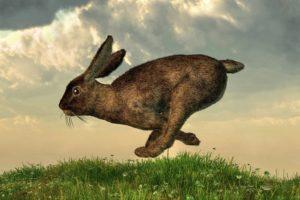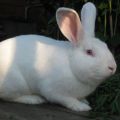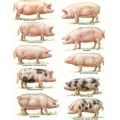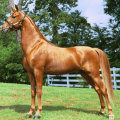Description of white giant rabbits, rules of keeping and crossing
Many farmers are engaged in breeding rabbits. The real favorites are the white giant rabbits. Raising animals allows you to get a sufficient amount of dietary tasty meat and excellent fur skins, which are in great demand among furriers. The maintenance and breeding of the breed does not require special conditions, therefore it is popular everywhere.
The origin of the white giant breed
Modern animals are the result of the work of German and French breeders on the albino rabbit Flandre breed, which is distinguished by tasty meat and thin bones. It was the white giant that became the basis for theeating other popular breeds (black-brown rabbit, Soviet chinchilla).
The white giant brought to Russia at the beginning of the 20th century had many drawbacks. The animals did not differ in vitality. The breed was characterized by low fertility, poorly developed maternal qualities, so a significant part of the offspring did not survive. However, over time, the breed was improved.
Description and characteristics of the rabbit
Distinctive features of the breed are a white giant with red eyes: an elongated body (55-60 cm long) with a strong bone, a long and narrow straight back, a wide rounded croup, a massive head with long and wide ears. The giant has wide-set, strong and long limbs.
In fur production, a rabbit skin with elastic and thick hair is in demand. White fur without marks is very widely used to imitate the pile of other fur-bearing animals (sable, fur seal). Due to good meat characteristics (the weight of an adult is 5-6 kg), albino rabbits are bred by many farms.
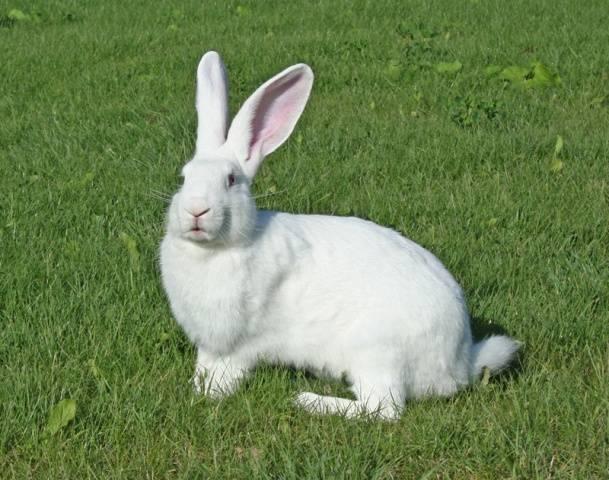
Positive and negative sides
Due to the merits of the rabbit, both large farms and individual rabbit breeders are bred for personal purposes. Pros of the white giant:
- spectacular fur and durable skin are in demand from converters;
- animals quickly gain weight (3-4-month-old rabbits are already slaughtered for meat);
- tender and juicy meat (the yield per adult is 70-80%).
When breeding a white giant, you need to take into account the shortcomings of the breed. The main disadvantage is the need to constantly monitor the selection of animals for mating. Incorrect breeding leads to breed degeneration. You also need to control the diet of animals, since overfeeding contributes to the obesity of animals that mate less often.
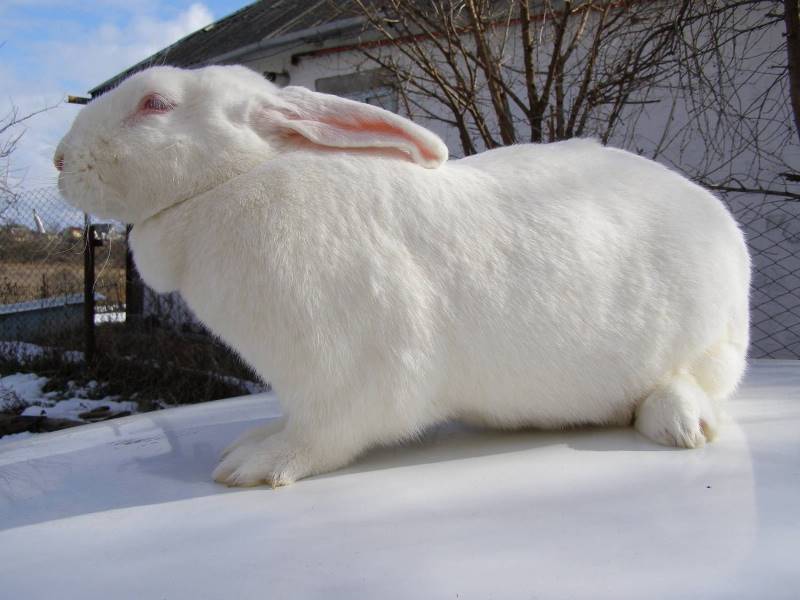
How to properly maintain and care for
It is the arrangement of straightening cages that becomes the key to the full development of animals. Structures should be spacious (taking into account the size of animals), protected from direct sunlight and drafts. Cage doors are most often made of metal mesh. The floor must be made even so that the animals do not injure their paws.
The main requirement for maintenance is keeping the stands clean. At least 2-3 cell cleanings are done every week. It is recommended to periodically disinfect structures for preventive purposes. The inner surfaces of the cells are whitewashed with lime.

What to feed the animal
When keeping a white giant, the emphasis in the diet is on traditional rabbit food. Large farms use crushed oat and barley.
Advice! It is not advisable to feed the animals with wheat, since the rabbit's body does not digest it well.
In the summer, they practice the use of fresh herbs. Rabbits are happy to eat cabbage leaves, vegetable tops and freshly cut grass (plantain, nettle, dandelion, quinoa are suitable). Alternatively, for breakfast, you can prepare a brewed mixture of freshly cut grass, finely chopped zucchini, pumpkin. Hay, grated carrots, summer preparations in the form of bunches of birch branches, willows add variety to the winter diet.

Basic breeding rules
Crossbreeding is not a problem as the animals are ready for the process all year round. When breeding animals, several rules are followed:
- healthy, strong and large animals are chosen for mating;
- as soon as the rabbit reaches the age of 5-6 months, they begin to plant her in the male's cage (for 1-2 hours);
- a week later the mating is repeated. If the rabbit does not allow the male, it means that fertilization took place at the first meeting.
Mating of animals is carried out in two ways: on the table and in the cage. Moreover, it is important to plant the female in the cage with the male, and not vice versa. Otherwise, the rabbit can defend the territory, and the meeting will end in a fight.
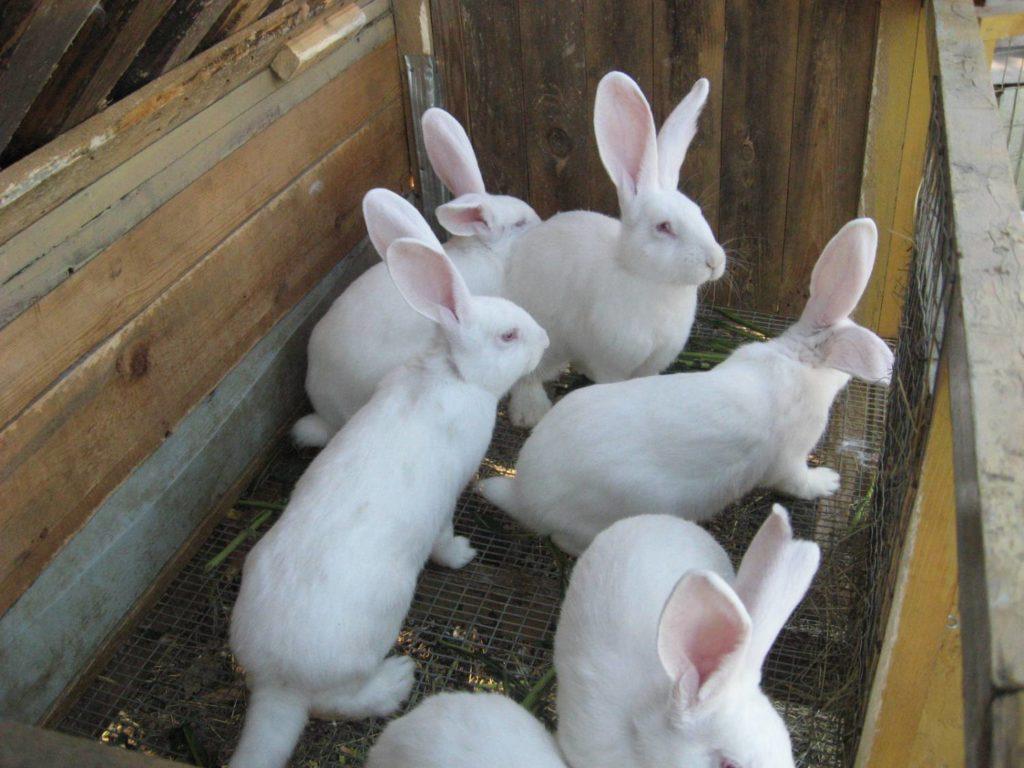
Diseases and methods of dealing with them
In conditions of improper maintenance, the susceptibility of animals to infections (myxomatosis, tularemia, listeriosis) increases. Timely vaccination helps protect the health of rabbits. Skin parasites are often the cause of diseases. The most common is ear mites. To get rid of it, the inner surface of the ears of rabbits is treated with camphor oil or a special mixture (mix glycerin, turpentine, kerosene).
Dirty litter or mesh flooring provokes paw disease - pododermatitis. If you do not start treatment on time, the disease ends with damage to the bones and tendons. Treatment of damaged areas with Levomikol ointment is the basis of treatment. You also need to lay a flat canvas on the floor and regularly disinfect the floor covering.
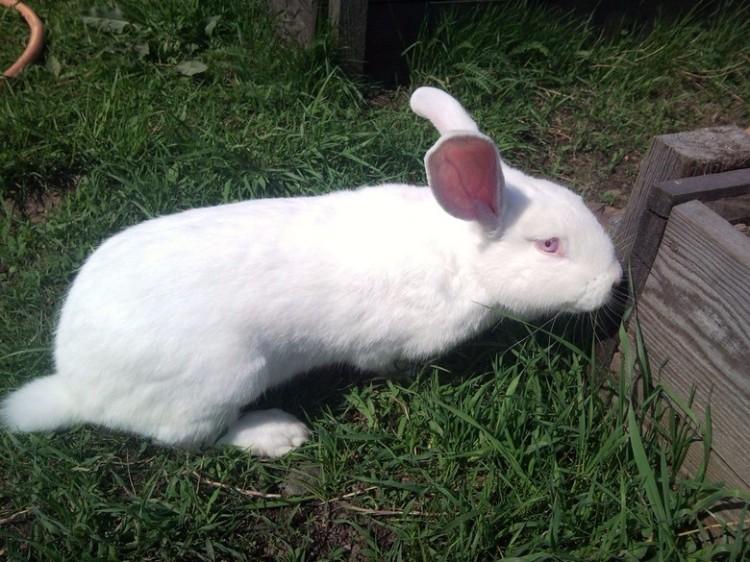
Where can you buy and how much does it cost
For sale for breeding offer rabbits aged 1.5-2 months. Farms in most regions are engaged in the sale of rabbits. Farmers offer any number of individuals. Small farms sell rabbits in the amount of 20-30 individuals.
The cost of baby rabbits varies, since it depends on the age of the animals. Some farms sell animals at a price per individual (fluctuates between 600-1000 rubles). The seller often lists the price per month. In this case, the cost is 200-350 rubles per month (then a one and a half month rabbit will cost 300-530 rubles, and a two-month one - 400-700 rubles).
Many farmers consider the White Giant breed to be the best choice for breeding. Raising rabbits allows you to get nutritious meat, strong skin with delicate fur in a short time. These rabbits are also kept as pets.
